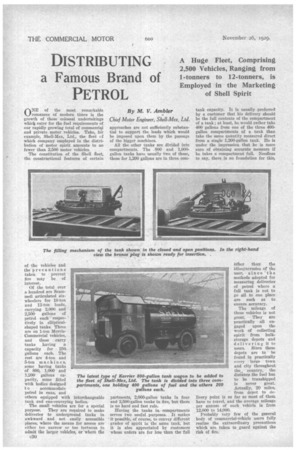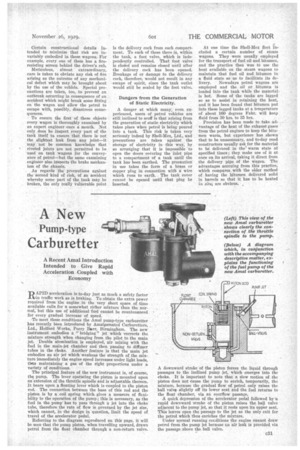DISTRIBUTING
Page 68

Page 69

If you've noticed an error in this article please click here to report it so we can fix it.
a Famous Brand of
PETROL
A Huge Fleet, Comprising 2,500 Vehicles, Ranging from 1-tonners to 12-tonners, is Employed in the Marketing of Shell Spirit
ONE of the most remarkable romances of modern times is the growth of those colossal undertakings which cater for the fuel requirements of our rapidly growing total of commercial and private motor vehicles. Take, for
Shell-Mex, Ltd., the fleet of which company employed in the distribution of motor spirit amounts to no fewer than 2,500 motor vehicles.
The constitution of the Shell fleet, the constructional features of certain of the vehicles and the precautions taken to prevent Are may be of Interest.
Of the total over a hundred are Scammell articulated sixwheelers for 10-ton and 12-ton loads, carrying 2,000 and 2,500 gallons of petrol each respectively in ellipticalshaped tanks. Three are on 1-ton MorrisCommercial vehicles, and these . carry tanks having a capacity for 250gallons each. The rest are 4-ton and 5-ton machines, some having tanks of 800, 1,000 and 1,200 gallons capacity, some fitted with bodies designed t o accommodate petrol in cans, and others equipped with interchangeable tank and can-conveying bodies.
The small vehicles are for a special purpose. They are required to make deliveries to underground tanks in awkward and not easily accessible places, where the means for access are either too narrow or too tortuous to admit the larger vehicles, or where the
By M. V. Ambler
Chief Motor Engineer, Shell-Mex, Ltd.
approaches are not sufficiently substantial to support the loads which would be imposed upon them by the passage of the bigger machines.
All the other tanks are divided into compartments. The 800 and 1,000gallon tanks have usually two of these, those for 1,200 gallons are in three corn partments, 2,000-gallon tanks in four and 2,500-gallon tanks in five, but there is no hard and fast rule.
Having the tanks in compartments serves two useful purposes. It makes it possible, of course' to convey different grades of spirit in the same tank, but it is also appreciated by customers whose orders are for less than the full
tank capacity. It is usually preferred by a customer that his delivery should be the full contents of the compartment of a tank ; at least, he would rather take 400 gallons from one of the three 400gallon compartments of a tank than take the same quantity measured direct from a single 1,200-gallon tank. He is under the impression that be is more sure of obtaining accurate measure if he takes a compartment full. Needless to say, there is no foundation for this,
'other than the idiosyncrasies of the user, since the methods adopted for measuring deliveries of petrol where a full tank is not to go all to one place are such as to ensure accuracy.
The mileage of these vehicles is not great. They are practically all engaged upon the work of collecting spirit from bulkstorage depots and delivering it to users. Since these depots are to be found in practically every large town and city throughout the_ country, the to distance the fuel has to be transhipped is never great. Actually, 20 miles, from depot to delivery point is as far as most of them have to travel, and the average mileage per annum of each vehicle is from 12,000 to 14,000.
• Probably very few of the general body of commercial-vehicle users fully realize the extraordinary precautions which are taken to guard against the risk of fire.
Certain constructional details intended to minimize that risk are invariably embodied in these wagons. For example, every one of them has a fireresisting screen behind the driver's cab.
Meticulous, almost extraordinary, • care is taken to obviate any risk of fire arising as the outcome of any meehanical defect which may be brought about by the use of the vehicle. Special precautions are taken, too, to prevent an outbreak occurring in consequence of an accident which might break some fitting on the wagon and allow the petrol to escape with, possibly, disastrous consequences.
• To ensure the first of these objects every, wagon is thoroughly examined by an expert engineer once a month. Not only does he inspect every part of the tank itself to ensure that there is not the slightest leak from any joint—it may not be common knowledge that riveted joints are not permitted to be used on tank wagons for the conveyance of petrol—but the same examining engineer also inspects the brake mechanism of the chassis.
As regards the precautions against the second kind of risk, of an accident whereby some part of the tank may be broken, the only really vulnerable point
Is the delivery cock from each compartment. To each of these there is, within the tank, a foot valve, which is independently controlled. That foot valve is clotied and remains closed until after the delivery cock has been opened. Breakage of or damage to the delivery cock, therefore, would not result in any escape of spirit, since the tank outlet would still be sealed by the foot valve.
Dangers from the Generation of Static Electricity.
A danger at which many, even experienced, users of petrol vehicles are still inclined to scoff is that arising from the generation of static electricity which takes place when petrol is being poured into a tank. This risk is taken very seriously indeed by Shell-Max, Ltd., and precautions are taken against the storage of electricity in this way, by so arranging that it is impossible 'to open the doors covering the inlet pipe to a compartment of a tank until the tank has been earthed. The precaution in use takes the form of a brass or copper plug in connection with a wire which runs to earth. The tank cover cannot be opened until that plug be Inserted. At one time the Shell-Mex fleet included a certain number of steam wagons. They were usually employed for the transport of fuel oil and bitumen, and the practice then was to use the heat available on the steam wagons to maintain that fuel oil and bitumen in a fluid state so as to facilitate its de livery. Nowadays petrol wagons are employed and the oil or bitumen is loaded into the tank while the material is hot. Some of the tanks are lagged so as to assist in retaining the heat, and it has been found that bitumen put into these lagged tanks at a temperature of about 160 degrees Fahr. will keep fluid from 30 hrs. to 35 hrs.
Provision has been made to take advantage of the heat of the exhaust gases from the petrol engines to keep the bitumen warm, but experience has shown that to be unnecessary, and to-day road constructors usually ask for the material to be delivered in the' warm state at specified times; they make use of it at once on its arrival, taking it direct from the delivery pipe of the wagon. The advantages accruing from this practice, which compares,with the older method of having the bitumen delivered solid in barrels so that it has to be heated in situ, are obvious.




























































































































